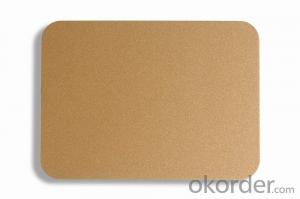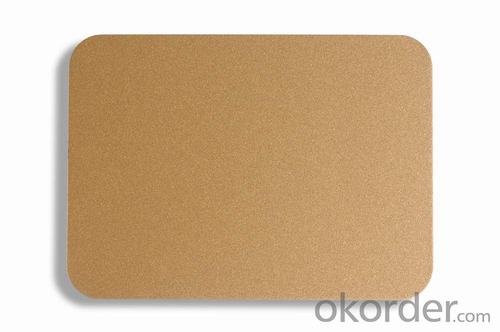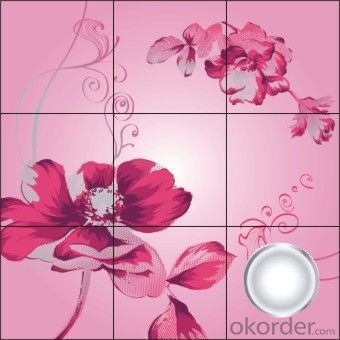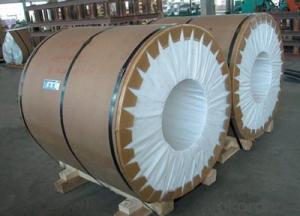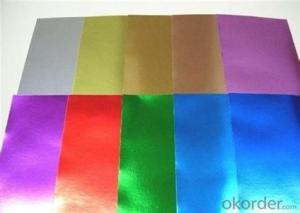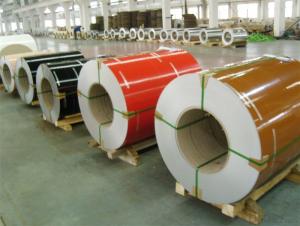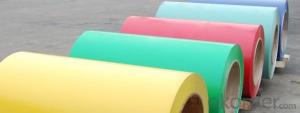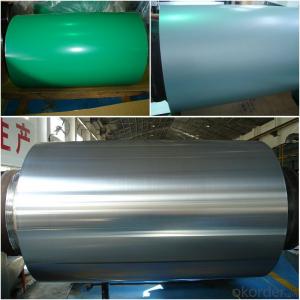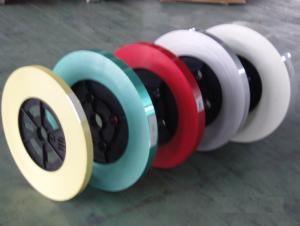Black and White PVDF/PE Coated Aluminum Coil
- Loading Port:
- Shanghai
- Payment Terms:
- TT OR LC
- Min Order Qty:
- 8 m.t.
- Supply Capability:
- 2000 m.t./month
OKorder Service Pledge
OKorder Financial Service
You Might Also Like
Specification
Structure of Aluminium Coated Coil with PVDF/PE Coating Description:
Coated aluminum coil/sheet are of a wide range of colors, which gives wonderful appearance no matter in residential and commercial constructions of great exhibition centers.
The coated aluminum coil/sheet have been widely used in the fields of construction and decoration( garage doors, ceiling etc.), electronic appliances, lighting decoration, air-condition air pipes, sandwich panels and drainages etc.
Main Features of the Aluminium Coated Coil with PVDF/PE Coating:
1) High flexibility
2) Impact resistance
3) Excellent weather-proof durability
4) Anti-ultraviolet
5) High erosion resist
Images of the Aluminium Coated Coil with PVDF/PE Coating:
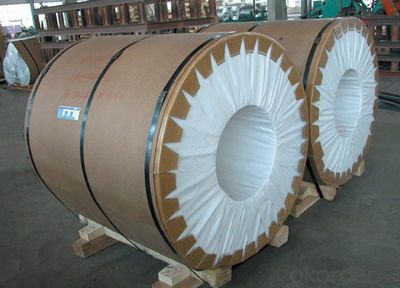
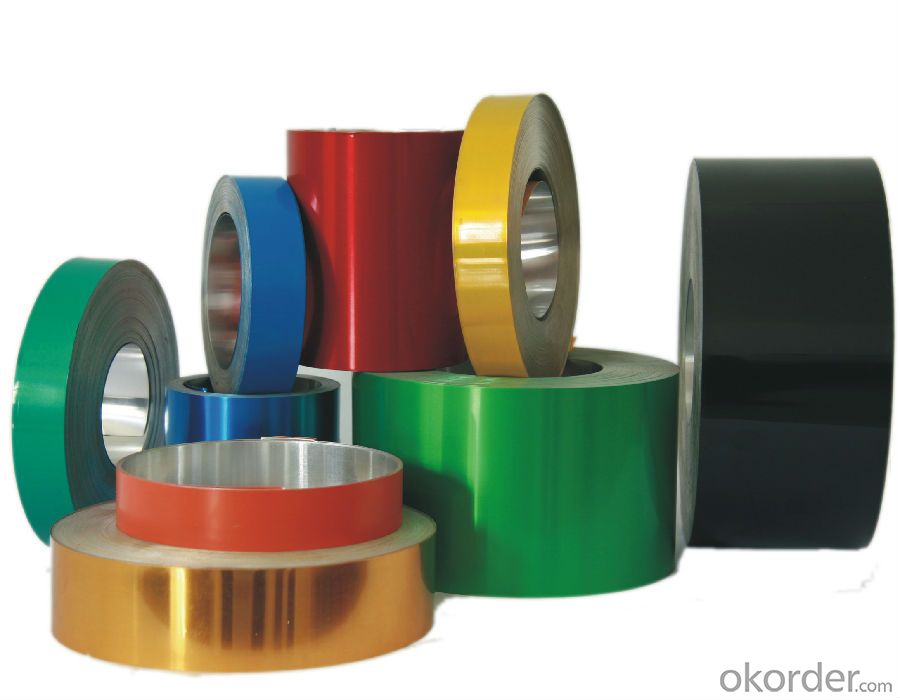

Aluminium Coated Coil with PVDF/PE Coating Specification:
Alloy | A1100,A3003,A1050,A8011 etc |
Temper | H16,H18,H24 |
Thickness | From 0.024mm to 1.2mm |
Width | Standard width:1240mm |
Special width:1300mm,1520mm,1570mm,1595mm | |
Diameter | Standard dia:1200mm |
Interior dia:150mm,405mm,505mm | |
Weight | 2.5 T/coil,3.0 T/coil |
Coating | PE, PVDF, AC |
Surface | Embossed, mill finish, coated |
Color | AS to code RAL |
Gloss | 10-90%(EN ISO-2813:1994) |
Coating Thickness | PE: more than 18 micron |
PVDF: more than 25 micron | |
Coating Hardness (pencil resistance) | More than 2h |
Coating adhesion | 5J(EN ISO-2409:1994) |
Impact Resistance | No peeling or cracking(50 kg/cm,ASTMD-2794:1993) |
Flexibility (T-bend) | 2T |
MEK resistance | More than 100 |
FAQ Aluminium Coated Coil with PVDF/PE Coating:
a.What is monthly capacity
---CNBM is one stated own company and our monthly capacity is about 2000tons.
b. Now which countries do you export your goods?
---Now we export to South East Asia,Africa, North America,South America ect.
- Q: How are aluminum coils used in the production of electrical conductors?
- Aluminum coils are used in the production of electrical conductors as they provide a lightweight and cost-effective alternative to copper coils. The coils are typically wound around a core to create a magnetic field when electricity passes through them, allowing for the efficient transmission of electrical energy. Aluminum's high conductivity and low resistance make it an ideal choice for manufacturing electrical conductors, resulting in improved energy efficiency and reduced production costs.
- Q: Are there any limitations to the maximum coil diameter of aluminum coils?
- Yes, there are limitations to the maximum coil diameter of aluminum coils. The maximum coil diameter is determined by several factors including the type and thickness of the aluminum, the equipment used for coiling, and the intended application of the coil. Generally, larger coil diameters can be achieved with thinner and more ductile aluminum alloys. However, as the coil diameter increases, it becomes more challenging to maintain the structural integrity of the coil and prevent deformation, wrinkling, or damage during handling and transportation. Additionally, the equipment used for coiling may have limitations in terms of the maximum diameter it can handle. Therefore, it is important to consider these factors when determining the maximum coil diameter for aluminum coils.
- Q: Can aluminum coils be fabricated or formed into different shapes?
- Yes, aluminum coils can be fabricated or formed into different shapes through various processes such as bending, rolling, stamping, or extrusion. These techniques allow for the creation of customized shapes and designs to fit specific applications or requirements.
- Q: a) Although Aluminium is a reactive metal, it is used to make door frames and window frames.b) Although Aluminium conducts heat, it is used to make blankets, which are good thermal insulators.
- a] AL is used to make frames because it is light, not costly and strong.
- Q: How are aluminum coils protected against UV exposure during storage?
- During storage, aluminum coils are typically safeguarded against UV exposure through the application of a protective coating or the use of UV-resistant packaging materials. UV degradation poses a significant risk to the coils, leading to discoloration, surface damage, and reduced performance. Consequently, manufacturers and distributors take special precautions to shield the coils from harmful UV rays. One popular approach involves applying a protective coating on the coil surface. This coating acts as a barrier between the aluminum material and UV radiation, preventing direct exposure. Usually, the coating consists of a specialized paint or lacquer that contains UV inhibitors. These inhibitors either absorb or reflect UV rays, minimizing damage to the coils. Furthermore, this protective layer preserves the aesthetic appearance of the coils and extends their lifespan. Aside from coatings, UV-resistant packaging materials can also be used to store aluminum coils. These materials are specifically designed to block or absorb UV radiation, creating a shield around the coils. Polyethylene films are a common choice for UV-resistant packaging, as they provide excellent UV protection. By storing the coils in such packaging, they are effectively safeguarded against direct sunlight and other sources of UV radiation. It is important to note that UV protection measures become particularly crucial during long-term storage or transportation, as the coils may be exposed to UV rays for extended periods. By implementing these protective measures, manufacturers and distributors ensure that the aluminum coils maintain their quality and performance, even when stored in environments with high UV exposure.
- Q: ok me and my father are trying to make thermite. we have the iron oxide but the aluminum we only have paste and i was wondering would it work the same as if we had the powder.and if it is differnt will it work for the thermite and what will it take to light it.
- The aluminum paste may or may not work. It depends on what the solvent is that the aluminum is dissolved in. Why not get a block of aluminum and a grinder, and make your own aluminum dust?
- Q: What are the different color options available for aluminum coils?
- There are several different color options available for aluminum coils. Some of the most common colors include white, black, gray, brown, and beige. These colors are achieved through a process called coil coating, where a layer of paint is applied to the aluminum coil. The paint is typically a high-quality, durable coating that is resistant to fading, chipping, and cracking. In addition to these standard colors, custom color options are also available, allowing for a wide range of choices to match any aesthetic preference or design requirement. These custom colors can be achieved through a color matching process, where the desired color is created specifically for the project. Overall, the variety of color options for aluminum coils ensures that there is a suitable choice for any application, whether it be for residential, commercial, or industrial purposes.
- Q: Is it possible to use aluminum coils in the construction of a solar charger or battery pack?
- <p>While aluminum coils can be used in various electrical applications due to their conductivity, they are not typically used in solar chargers or battery packs. Solar chargers and battery packs usually require materials with higher conductivity and specific properties for efficient energy transfer and storage. Copper is more commonly used for wiring in these devices due to its superior conductivity compared to aluminum. Aluminum may not provide the necessary efficiency and could lead to energy loss. For the best performance in solar chargers and battery packs, it's recommended to use materials specifically designed for these applications, such as high-quality copper wiring and appropriate battery cells.</p>
- Q: Can aluminum coils be anodized for enhanced durability?
- Yes, aluminum coils can be anodized for enhanced durability. Anodizing is a process that creates a layer of aluminum oxide on the surface of aluminum, making it more resistant to corrosion, wear, and scratches. This layer also provides added protection against UV rays and harsh environmental conditions. By anodizing aluminum coils, they become more durable and can withstand prolonged use in various industries such as construction, automotive, and electronics. Additionally, anodized aluminum coils can be further treated with additional coatings or finishes to enhance their appearance and offer further protection. Overall, anodizing aluminum coils is a widely used and effective method to enhance their durability and prolong their lifespan.
- Q: How do aluminum coils perform in extreme temperatures?
- Aluminum coils are known for their excellent performance in extreme temperatures. Unlike other metals, aluminum has a low melting point of 660°C (1220°F), which means it can withstand high heat without melting or deforming. This makes aluminum coils ideal for use in industries that require heat resistance, such as automotive, aerospace, and HVAC. In extreme cold temperatures, aluminum coils also perform exceptionally well. Aluminum has a high thermal conductivity, which allows it to efficiently transfer heat. This means that even in freezing conditions, aluminum coils can quickly and effectively warm up and maintain a consistent temperature. Moreover, aluminum is highly resistant to corrosion, making it suitable for use in various outdoor applications where it may be exposed to harsh weather conditions. It does not rust or deteriorate when subjected to extreme temperatures, making it a durable and reliable choice. Overall, aluminum coils are designed to withstand extreme temperatures, making them a preferred choice for industries that require heat resistance and durability.
Send your message to us
Black and White PVDF/PE Coated Aluminum Coil
- Loading Port:
- Shanghai
- Payment Terms:
- TT OR LC
- Min Order Qty:
- 8 m.t.
- Supply Capability:
- 2000 m.t./month
OKorder Service Pledge
OKorder Financial Service
Similar products
Hot products
Hot Searches
Related keywords
